Question
What is an example of a population?
all the arthropods in a pond
all the chital deer found in a forest
all the lions that lived from 1950–2000
all the flowering plants in a wood
▶️Answer/Explanation
An example of a population is:
B. all the chital deer found in a forest
Chital deer (Axis axis) are a specific species of deer. A population, in biological terms, refers to a group of individuals of the same species living in the same geographical area and capable of interbreeding. Here’s how this option fits the criteria:
Same Species: Chital deer all belong to the species Axis axis. They share common genetic traits and characteristics that define their species.
Same Geographic Area: The chital deer are found in a single forest. This means they inhabit the same specific geographic area.
Capable of Interbreeding: Chital deer within the same species can interbreed and produce fertile offspring. This is a key criterion for determining if a group constitutes a population.
Question
What is used to reduce competition from weeds when growing crops?
A deforestation
B fertilizer
C herbicide
D insecticide
▶️Answer/Explanation
C. Herbicide
Herbicides are chemicals specifically designed to control or eliminate unwanted weeds in agricultural fields. They are used to reduce competition from weeds, allowing crops to grow more effectively without being overshadowed or outcompeted for resources like water, sunlight, and nutrients. Herbicides target various aspects of weed growth, such as inhibiting their ability to photosynthesize or disrupting their growth hormones, thus helping to ensure better crop yields.
Question
What name is given to the diagram below?
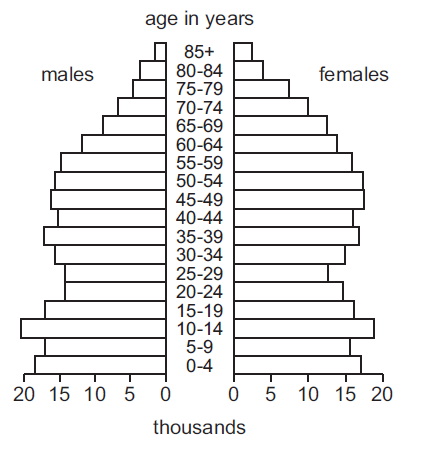
A a food web pyramid
B a population pyramid
C a pyramid of biomass
D a pyramid of energy
▶️Answer/Explanation
B
A population pyramid is a graphical representation of a population’s age and gender distribution. It consists of two back-to-back bar graphs, one representing males and the other females. The vertical axis represents age groups, typically in five-year increments, while the horizontal axis represents the percentage or number of individuals in each age group. The shape of the pyramid provides insights into the population’s characteristics, such as whether it’s young or aging, and whether there’s gender balance or disparity. A wide base indicates a higher proportion of young individuals, while a narrowing top suggests an older population. The pyramid’s structure can also reveal trends in birth rates, life expectancy, and demographic changes over time.
Question
The graph shows how the population of the world increased from 1650 until the present day.
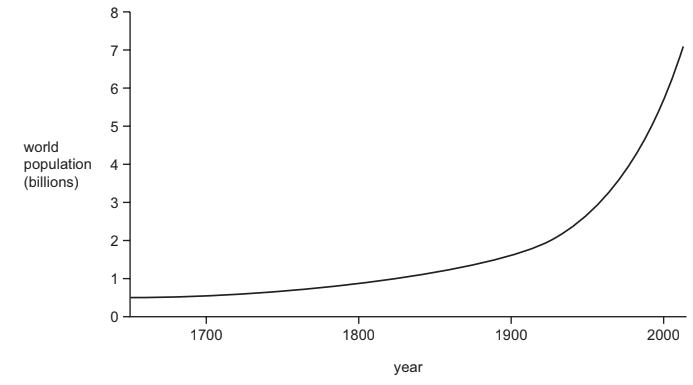
Which phases of the usual sigmoid growth curve are missing in this graph?
A death and lag
B exponential (log) and stationary
C lag and exponential (log)
D stationary and death
▶️Answer/Explanation
D
Stationary and death phases of the usual sigmoid growth curve are missing in this graph. The “stationary” and “death” phases refer to two specific phases in the sigmoid (S-shaped) growth curve, which represents the population growth of a species over time. This curve consists of several phases that describe different stages of population growth.
Stationary Phase: This phase occurs when the population growth starts to slow down. The population reaches a point where it levels off, and the growth rate decreases. This usually happens when the population approaches the carrying capacity of its environment—the maximum number of individuals the environment can sustainably support. As resources become scarcer and competition for them intensifies, the population growth rate decreases until it reaches equilibrium.
Death Phase: In this phase, the population growth rate becomes negative, indicating a decline in population. The resources are now severely limited, and the environment cannot support the existing population. This can lead to increased mortality, decreased birth rates, and potentially even population collapse.
Question
The graph shows the growth curves for boys and girls.
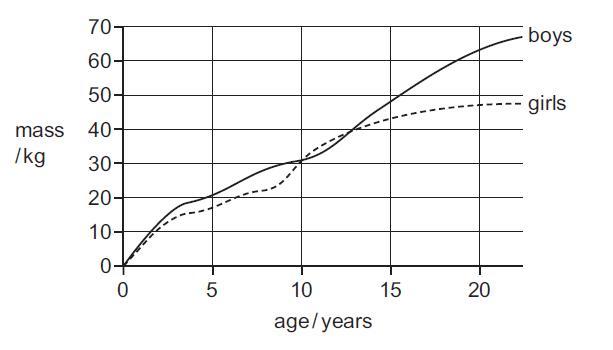
What is the approximate average growth rate of boys between 10 and 15 years old?
A 3.5 kg per year
B 18 kg per year
C 32 kg per year
D 50 kg per year
▶️Answer/Explanation
A
The correct answer is A: 3.5 kg per year.
Between the ages of 10 and 15, the average growth rate for boys is typically around 3.5 kilograms per year. This growth rate is an approximation and can vary based on individual factors, genetics, nutrition, and overall health. This means that, on average, a boy’s weight increases by approximately 3.5 kg each year during this period.
During adolescence, growth spurts occur as part of the normal development process. Boys tend to experience a significant growth spurt during this age range. This growth is influenced by various factors, including genetics, nutrition, hormones, and overall health. The growth rate is not constant throughout these years; it might be slightly higher during the peak of the growth spurt and slower during other times.
Option B (18 kg per year), option C (32 kg per year), and option D (50 kg per year) are not accurate representations of the typical growth rate for boys between 10 and 15 years old. These rates would be abnormally high and not consistent with the usual growth patterns observed during adolescence.
Question
In 2005, fifteen mice were set free on an island where mice had never lived before. The table
shows how their population changed over the next three years.
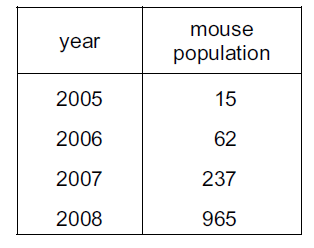
What caused the population change shown in the table?
A lack of food
B lack of predators
C lack of space
D lack of water
▶️Answer/Explanation
B
The table shows that the population of mice increased significantly over the three-year period. This is indicated by the fact that the number of mice went from 15 in the first year to 100 in the third year. Such a rapid and unchecked increase in population suggests that there was likely a lack of predators on the island.
If there were an adequate number of predators present, they would have naturally controlled the mouse population by preying on them, thus preventing such a dramatic population increase. Without predators to keep their numbers in check, the mice were able to reproduce and thrive, leading to the observed population change. This is a classic example of how predator-prey dynamics can influence population changes in an ecosystem.
Question
The table shows the birth rates and death rates in four countries.
Which country will double its population most quickly?
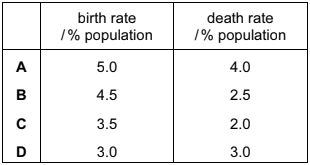
▶️Answer/Explanation
B
To determine which country will double its population most quickly, we can use the concept of population growth rate. The population growth rate is calculated as the birth rate minus the death rate. This represents the net increase in population due to births and deaths.
Population Growth Rate = Birth Rate – Death Rate
Let’s calculate the population growth rates for each country:
A. Population Growth Rate = 5.0% – 4.0% = 1.0%
B. Population Growth Rate = 4.5% – 2.5% = 2.0%
C. Population Growth Rate = 3.5% – 2.0% = 1.5%
D. Population Growth Rate = 3.0% – 3.0% = 0.0%
The country with the highest population growth rate will double its population most quickly. In this case, country B has the highest population growth rate of 2.0%, so it will double its population more quickly compared to the other countries. Therefore, country B is the answer.
Question
The graph shows the growth of the human population of the world.
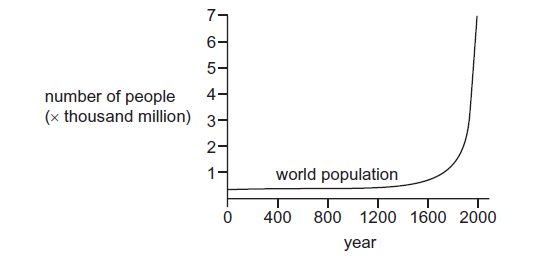
Between which years did the population grow fastest?
A 0 – 800
B 800 – 1200
C 1200 – 1800
D 1800 – 2000
▶️Answer/Explanation
D
The period between 1800 and 2000 (option D) is known for the most rapid population growth in human history. This era is often referred to as the “population explosion.” During this time, several significant factors contributed to the rapid growth of the human population:
Industrial Revolution: The Industrial Revolution, which began in the late 18th century and continued through the 19th century, brought about major advancements in technology, agriculture, and medicine. This led to improved living conditions, increased food production, and better healthcare, resulting in lower mortality rates and higher birth rates.
Medical Advances: The 19th and 20th centuries saw significant advancements in medical science, including the development of vaccines, antibiotics, and improved sanitation practices. These innovations helped control the spread of diseases and reduce mortality rates, leading to a population increase.
Agricultural Innovations: Innovations in agriculture, such as the introduction of new crop varieties and better farming techniques, increased food production and allowed societies to support larger populations.
Urbanization: The industrialization and urbanization that occurred during this period led to people moving from rural areas to cities in search of better opportunities. Urban areas often experienced higher birth rates, contributing to population growth.
Global Connectivity: Improved transportation and communication systems during the 19th and 20th centuries facilitated the movement of people and goods across the world, enabling the global population to grow more rapidly.
Question
What is the correct sequence for the stages in a sigmoid population growth curve?
A lag → log → stationary
B log → lag → stationary
C stationary → lag → log
D stationary→ log → lag
▶️Answer/Explanation
The correct sequence for the stages in a sigmoid (S-shaped) population growth curve is:
A. Lag phase → Log phase → Stationary phase
Here’s an explanation for each stage:
Lag Phase: In this initial stage, the population is just establishing itself in a new environment. Growth is slow because individuals are adapting to the environment, finding resources, and reproducing at a low rate.
Log Phase (Exponential Growth): In this phase, conditions are favorable, resources are abundant, and the population experiences rapid exponential growth. The growth rate is at its maximum during this stage.
Stationary Phase: As resources start becoming limited and environmental factors start affecting the population, the growth rate slows down. The population stabilizes and reaches a point where births and deaths are roughly balanced. This results in a relatively constant population size.
Question
The graph shows part of a growth curve for a bacterial population
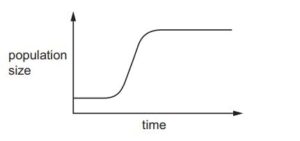
What is missing from the graph?
A the death phase
B the exponential phase
C the lag phase
D the stationary phase
▶️Answer/Explanation
A
The correct answer is A – the death phase.
The growth curve for a bacterial population typically consists of four main phases: lag phase, exponential (log) phase, stationary phase, and death phase. These phases represent different stages of bacterial population growth.
The given graph is missing the death phase, which comes after the stationary phase. During the death phase, the bacterial population starts to decline due to various factors such as nutrient depletion, accumulation of waste products, and other adverse conditions. This phase is characterized by a decrease in the number of viable bacteria over time.
So, the complete order of the growth curve phases is: lag phase → exponential phase → stationary phase → death phase.
Question
The diagram shows the age structure of a human population.
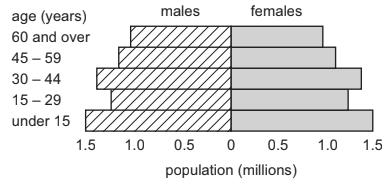
Which age group has the largest number of people?
A 60 and over
B 45-59
C 30-44
D under 15
▶️Answer/Explanation
D
Based on the information provided, the age group with the largest number of people is “D – under 15.” he pyramid-shaped age structure diagram represents the distribution of different age groups in a population, which typically shows a larger base representing the younger age groups and gradually tapering upwards as the age groups get older. The width of each age group’s section in the pyramid indicates the number of people in that age group. The wider the base of the pyramid, the larger the number of people in that age group. In this case, since the “under 15” age group has the widest base in the pyramid, it means that there are more people in that age group compared to the other age groups shown in the diagram.
Question
The graph shows a population growth curve.
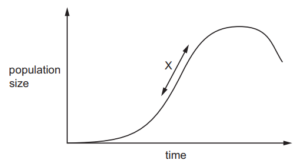
Which factors would cause region X on the graph to become steeper?
A decrease in predation, decrease in food supply
B increase in food supply, decrease in disease
C increase in food supply, increase in predation
D increase in predation, decrease in disease
▶️Answer/Explanation
B
In a population growth curve, the steepness of a region typically represents the rate of population growth. A steeper curve indicates a faster growth rate, while a shallower curve indicates a slower growth rate.
Option B suggests an increase in food supply and a decrease in disease. Both of these factors would contribute to an increase in the population growth rate in the given region (X).
1. Increase in Food Supply: When the food supply increases, individuals in the population will have more resources available to them. This can lead to higher reproductive success, better survival rates, and overall faster population growth.
2. Decrease in Disease: A decrease in disease means that fewer individuals in the population will be affected by illnesses that could otherwise reduce their survival and reproductive capabilities. This would also contribute to a higher growth rate.
Both of these factors, working in tandem, would lead to a steeper growth curve in region X. Therefore, option B is the correct answer.
Question
Which factor will cause a decrease in population size?
A decreased food supply
B decreased predation
C decreased disease
D decreased death rate
▶️Answer/Explanation
The factor that will cause a decrease in population size is:
A. Decreased food supply
When there is less food available, individuals within a population may struggle to find enough sustenance to survive and reproduce. This can lead to decreased reproduction rates, higher mortality rates, and overall reduced fitness for the individuals in the population. Over time, these factors can contribute to a decline in the population size.
Question
Which of these is a population?
1 all the insects in a rainforest
2 all the tigers in a rainforest
3 all the kapok trees in a rainforest
A 1, 2 and 3 B 1 only C 1 and 2 only D 2 and 3 only
▶️Answer/Explanation
D
A population refers to a group of individuals of the same species that live in the same area and can interbreed with one another. In this case, option 2 (“all the tigers in a rainforest”) and option 3 (“all the kapok trees in a rainforest”) are populations because they both refer to groups of individuals of the same species (tigers and kapok trees) that live in the same area and can potentially interbreed.
Option 1 (“all the insects in a rainforest”) is not a population on its own because insects constitute a highly diverse and numerous group of species, each with their own unique characteristics and breeding behaviors. Therefore, they are not a single species that can be considered a population in this context.
So, the correct answer is D: 2 and 3 only.
Question
The graph shows the changes in the populations of predator and prey over a period of time.
Which point on the graph shows a decrease in predator population?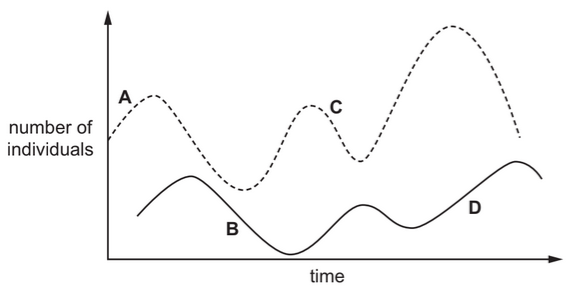
▶️Answer/Explanation
B
In predator-prey dynamics, the predator population usually follows the changes in the prey population with a certain time lag. This relationship often creates a pattern known as the predator-prey cycle, where increases in prey population lead to increases in predator population, and subsequently, decreases in prey population lead to decreases in predator population.
In the graph, the time on the x-axis and population on the y-axis, there is a decrease in predator population which is observed as a downward trend in the predator population curve. At Point B, number of individuals goes down, that represents the decrease in predator population. This point should be situated after a peak in the predator population following a peak in the prey population.
Question
The graph shows a population growth curve for a species of insect which has been reintroduced
to an island from where it had previously become extinct.
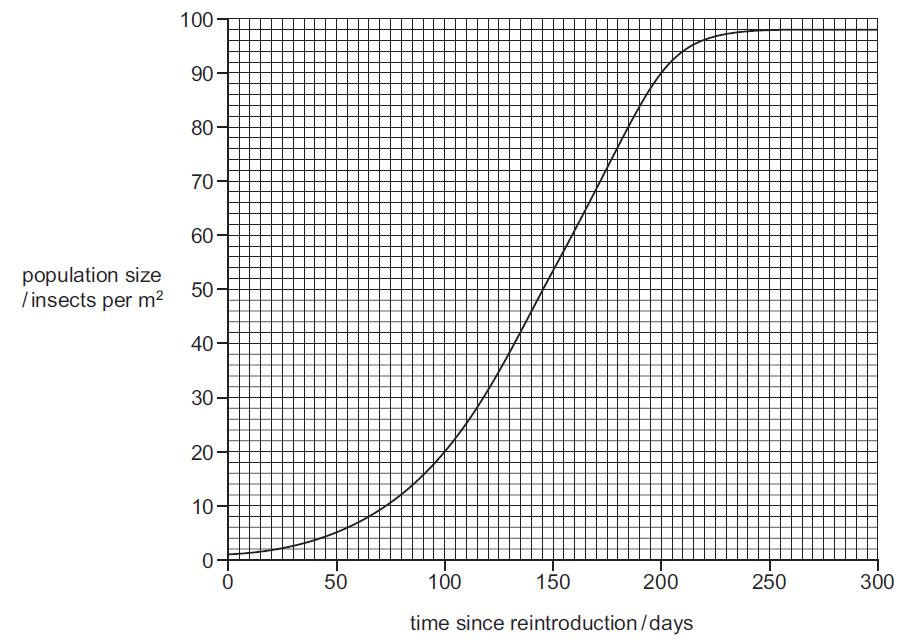
How long after reintroduction does the insect population size start to become limited by resources
such as food?
A 50 days B 100 days C 150 days D 200 days
▶️Answer/Explanation
D
The correct answer is D – 200 days.
In the context of the population growth curve for the reintroduced insect species, the population size initially goes through a phase of exponential growth. This means that the population is growing at an increasingly fast rate, with each individual producing more offspring, and the population size doubles in a relatively short period. During this phase, the population is not yet limited by resources such as food, as there are still ample resources available to support the rapid growth.
However, as the population continues to grow, it eventually reaches a point where the available resources start becoming scarce in comparison to the number of individuals in the population. This leads to a slowdown in the population growth rate, and the population enters a phase called the “logistic growth phase.” In this phase, the growth rate starts to decrease, and the population size stabilizes around the carrying capacity of the environment, which is the maximum population size that the environment can sustain with the available resources.
In the given options, option D – 200 days, represents a time period that is relatively far into the growth curve. By this time, the initial exponential growth phase would likely have started to slow down as the population encounters limitations in resources like food. This is when the population size starts to become limited by resources, leading to a transition from exponential growth to logistic growth.
Options A, B, and C are earlier time points, and the population would still be in the phase of rapid exponential growth during these periods, without being significantly limited by resources.
So, the correct answer is D – 200 days.
Question
What is an example of a population?
A all the arthropods in a pond
B all the crocodiles in a river
C all the plants in a wood
D all the zebras that lived from 1990–2010
▶️Answer/Explanation
A
An example of a population is “A) all the arthropods in a pond.” A population refers to a group of individuals of the same species that live in the same geographical area and are capable of interbreeding. In this case, all the arthropods (which are a type of invertebrate animals with jointed limbs and segmented bodies, including insects, spiders, and crustaceans) living in a particular pond would constitute a population. This group shares the same species characteristics and occupies the same habitat, making it a population. The other options don’t represent populations because they mix different species (crocodiles, plants, zebras) or refer to a specific time range for zebras rather than a specific geographical area.